These examples of tourism promotion during a pandemic show you how to get things right.
The travel and tourism sector has been deeply affected by the coronavirus pandemic leaving many small businesses wondering: What do we do now and where do we go from here?
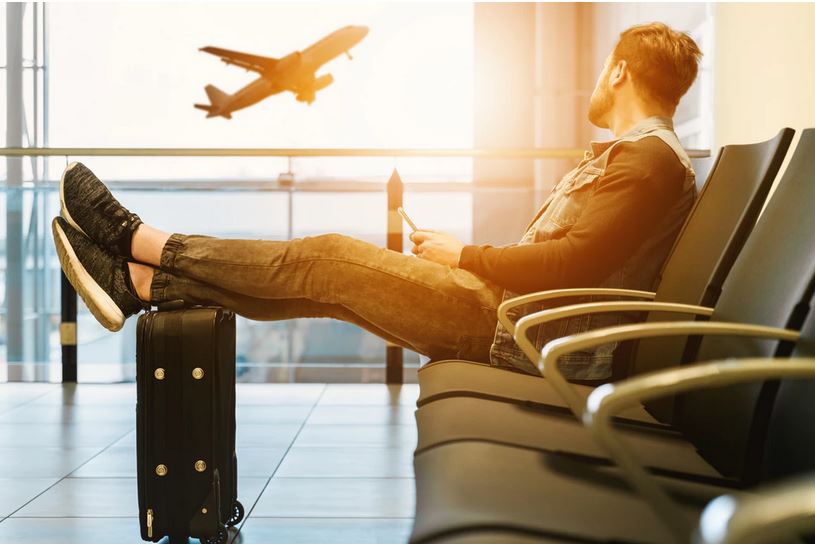
Destination marketing: What do we do now?
Times are tough right now but it’s important to look forward and think ahead. That means tackling the questions of:
- Where do we see ourselves (and this industry) going?
- What can we do right now?
- And how do we do it on a tight budget?
Under regular conditions – in other words life as we knew it pre-pandemic – it was hard enough to cut through the noise. To promote your destination, make your presence known, and market your offers.
In the New Normal, you face fresh challenges: New considerations to prepare for; customers’ changed preferences, priorities and even travel purchase journeys; and in some instances entirely new markets and segments to pivot to.
Don’t miss: Destination Marketing: Post-lockdown Travel and Tourism Trends
All this to say, pandemic or not, travel and tourism brands need to stay on top of their marketing game.
Because when domestic travel becomes a practical possibility again – and when the world re-opens for international leisure travel – you don’t want to be in a mad rush to compete for the attention (and interest) of a limited initial pool of travelers.
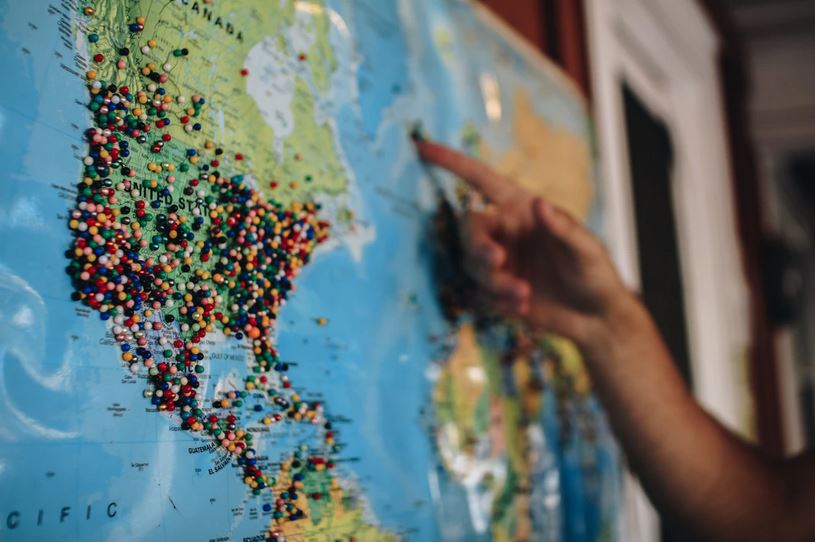
Travel marketing during a pandemic
While the world of travel and tourism came to a standstill earlier this year, destination marketing (and advertising your services) has to resume at some point. Nevertheless you probably have a lot of concerns and questions about how to go about it.
For example:
- Would it be completely tone deaf to promote leisure travel at this time?
- Is it worth the ad spend to market a destination when (1) no one really wants to travel these days anyway, (2) many borders remain closed to non-essential travel, and (3) people don’t have the financial means to go on vacation any time soon?
- What’s the appropriate way to promote travel when the world is still grappling with the novel coronavirus and its impact on all facets of society and economy?
- How do you keep interest alive for your destination?
- What can you do to stay top of mind if you don’t have the budget to advertise the way you used to?
Let’s take a look at what others – airlines, tourism boards, and tour operators – have been doing since the introduction of lockdowns around the world and see what you can learn from them.
Travel marketing and communication inspiration (from those doing it right!)
Keep valued customers regularly updated
From grounded flights to a much reduced schedule and flight network, airlines have taken a massive hit since travel bans and lockdowns came into effect. But that didn’t stop them from keeping in touch with their frequent fliers and future passengers. In fact, many seemingly ramped up their communication efforts – beyond flight cancellation notices!
Here are some best practices of tourism promotion during a pandemic plus the key takeaways you can apply to your own business.
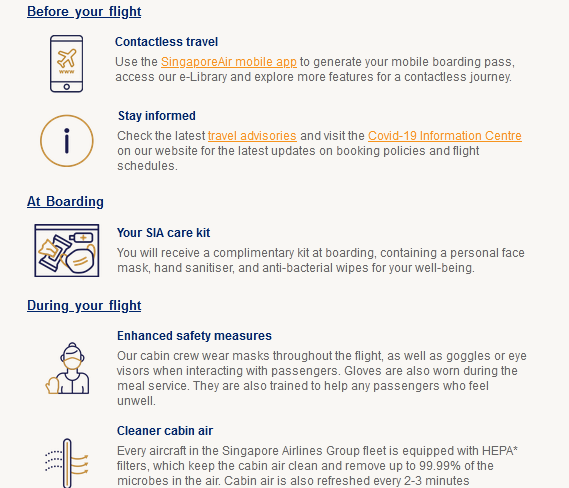
1. Instill trust and confidence
Unless you can convince people that (1) you’re doing everything to make travel as safe as possible and (2) you are being transparent with regards to your efforts, you’ll find yourself scrambling to win back the trust and confidence of your customers.
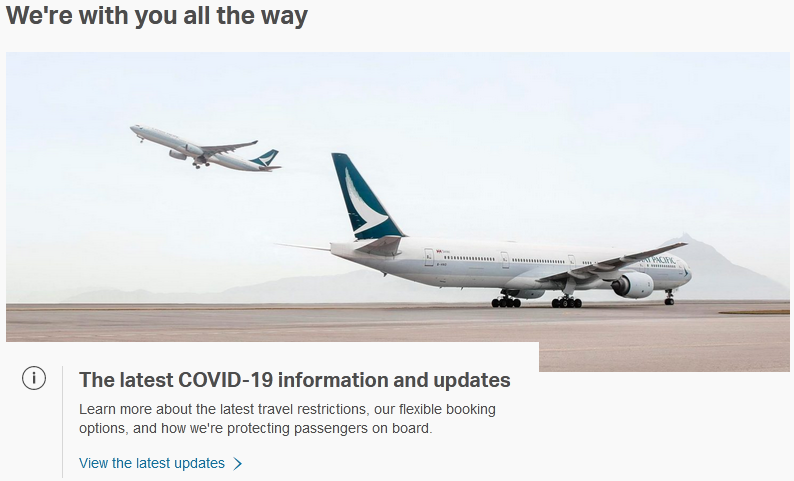
Make it a point to highlight the latest information and updates your customers need to know to make informed decisions.
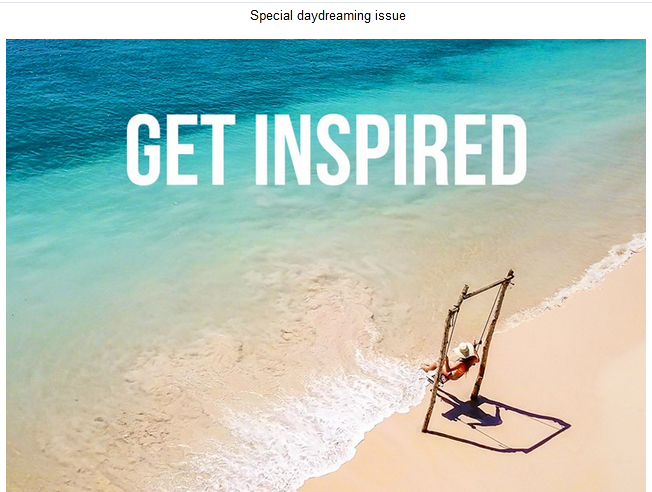
2. Reignite excitement and anticipation
You know that many people all around the world have been feeling cooped up within their own four walls, daydreaming of their next getaway. But that’s exactly what it is right now: just a dream.
So to move people from their current state to one where they’re ready to embark on their first post-lockdown holiday, you will first have to stimulate wanderlust and build anticipation all over again.
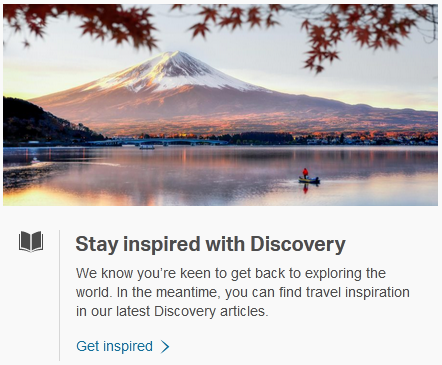
That’s precisely what KLM recently did with a special daydreaming edition of their newsletter and what Cathay Pacific’s encouraging you to do through their Discovery articles. Most importantly, these places highlight destinations they fly to and what awaits the reader there.
3. Adapt your marketing to suit today’s needs and immediate priorities

Pay extra attention to new opportunities and the segments that can get your business going again soonest.
REMINDER
Don’t disregard or neglect those that aren’t in a position to travel right now. Communicate with them just the same. Make sure they feel equally important and valued now as they did before.
Qatar Airways have done just that by pivoting their ad towards getting passengers home, rather than bringing them elsewhere. Aside from being in tune with the times, it’s also a great way to appeal to those who simply want to get back home—wherever home may be.
Build anticipation
For destination marketers, it really comes down to two important questions:
- How do we make sure people will still want to come here in the future?
- What do we have to do to motivate them to eventually take action?
Let’s consider the two main categories of travelers – those who have had to postpone their trips and those without existing bookings but that you want to attract – and the ways various tourism boards have crafted tone-appropriate content to inspire and promote their destination during this pandemic.
1. Address the giant COVID-19 elephant in the room
Whatever your sector may be, there’s no avoiding the Coronavirus Situation. You have to address it and the best way to do so is by being honest, upfront and always transparent. You must be a trusted source of the most current facts and figures as they relate to your destination.

In other words, even though you aren’t the ministry of health, you still have to be on top of the situation and provide potential visitors with regular and timely updates.
What should you include? Here are a few basics.
- What’s the situation on the ground?
- What are you doing to protect visitors / guests / customers?
- What can they expect in terms of new protocols or arrivals procedures?
- Where can they read more about your country’s response to coronavirus?
- What should travelers do if they suspect that they have fallen ill during their travels?
2. Remind travelers what you have to offer
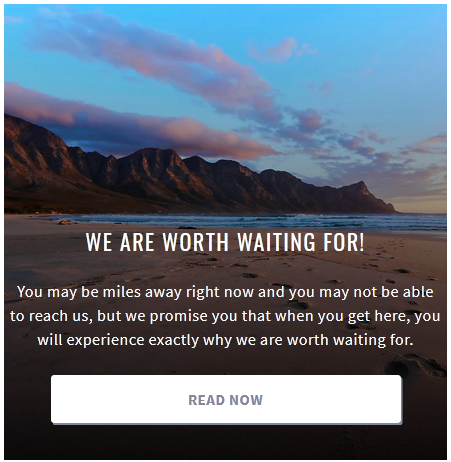
Countries are at different stages of easing lockdown restrictions but everyone’s on the same page: for now, don’t venture too far away.
But that doesn’t mean you can’t tease what’s awaiting future travelers with a wide array of awesome content to engage, excite and inspire. Cape Town’s “we are worth waiting for” campaign is a great example.
3. Show people what they can expect (and look forward to)

During the depressing first few weeks of the coronavirus pandemic, 360° virtual tours and destination-specific videos were a great distraction and entertaining way to pass the time.
They also served as inspiration and something to look forward to—a light at the end of the long and dark tunnel.
What you feature can be just about anything worth seeing:
- Virtual tours of popular attractions at your destination
- Livestreams from attractive locations like the Alps, countryside or even the beach
- Videos that showcase the beauty of your destination
- Stories from the ground:
- how the community is pulling together;
- how businesses are preparing for tourists’ return;
- and how you’re all looking forward to welcoming them back again in the future.
The Japanese region of Okinawa took things one step further. They offer a comprehensive ‘experience Okinawa from home’ guide.
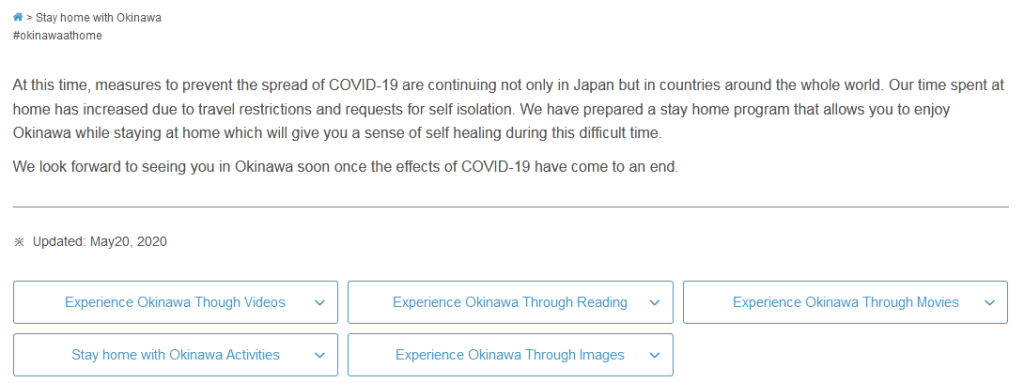
You can experience the island through videos, images, reading materials, movies and activities that you can try at home.
4. Start at home

The Hong Kong Tourism Board offers a stellar example of how to revitalise the tourism sector by starting at home.
They’re targeting locals first with a ‘holiday at home’ initiative that has awesome offers in every possible category from hotel discounts through to amazing shopping deals.
Beyond promo deals, they also share ideas on how locals can enjoy and explore the place they call home.
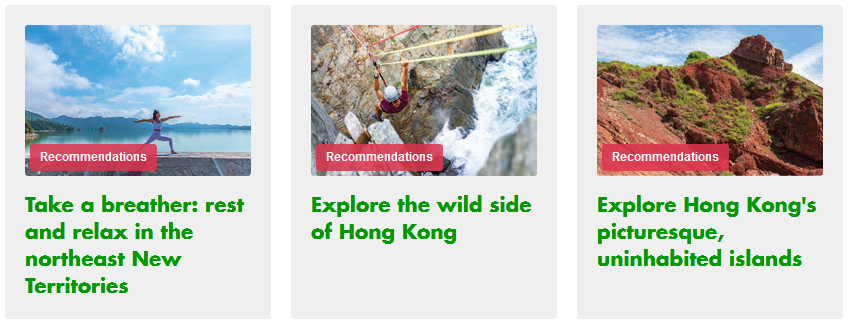
The bonus is that all of this material, content and promotional offers can simultaneously be applied to international arrivals! (Hit two birds with one stone, if you will.)
Employ a two-pronged approach
Survival isn’t just about today – it’s also about tomorrow. In other words it’s about finding new prospects to tide you over right now while anticipating the return of former business opportunities when things settle down.
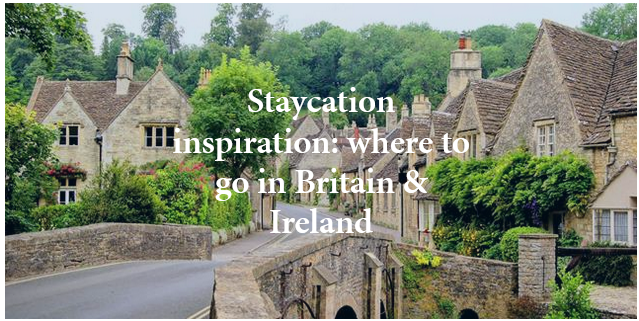
1. Be fast and flexible
Now is the time to be nimble, creative and willing to try new things—even if that means deviating from what you’ve always done.
Because if you focus purely on international destinations or attracting foreign guests, then the road to recovery is going to be a lot longer for you than if you were willing to explore business opportunities at home.
Some examples include:
- Promote staycations.
- Develop itineraries to help residents rediscover their own home town, local community, or neighbouring province.
- Target entirely new segments, e.g. senior travelers ® adventurous younger travelers
2. Find ways to encourage future trips
Because of all the uncertainty around the coronavirus, it’s hard to figure out just how soon people will be willing to get back out there—and if it will be realistically possible.
Nevertheless, your business needs you to find ways to inspire future trips while, at the same time, alleviate concerns clients may have with regards to the uncertainties of travel.
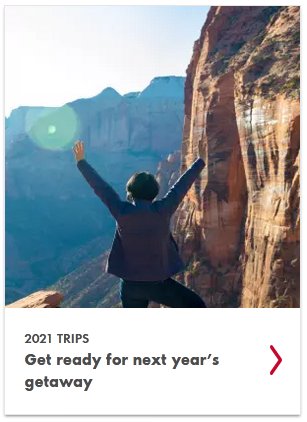
Trafalgar, for example, has started highlighting potential end of year escapes and promoting trending trips to inspire travel in 2021. Meanwhile, Collette is inviting you to take advantage of travel deals while they’re available.
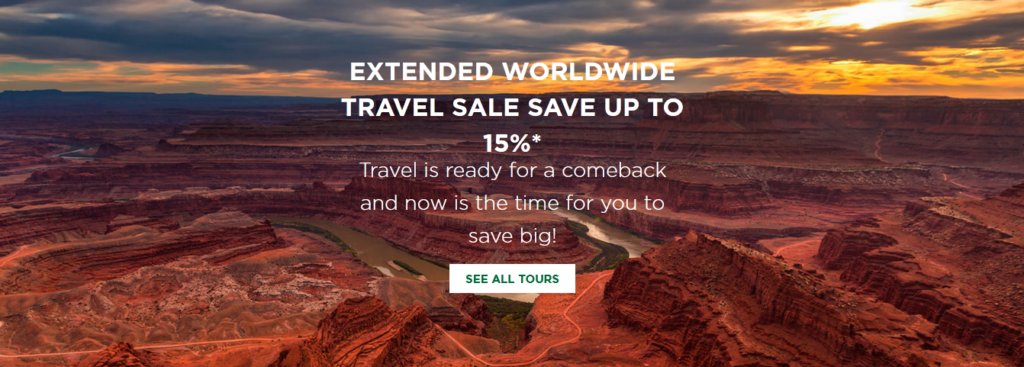
Tourism marketing on a limited budget
After issuing refunds, paying suppliers, and no new bookings for the past few months, frankly, the money’s gone. So what can you do to keep your marketing efforts going on a budget?
Now that you have some examples of tourism promotion during a pandemic, here are some budget-friendly ideas and further reading to get you started.
1. If you haven’t already been doing so, it’s about time you start blogging.
- Should your hotel have a blog?
- Business blogging: how your small business benefits
- Business blog content strategy – where to start
Don’t have time to blog? Here’s how I can help.
2. Make good use of that email list and get cracking on awesome newsletters!
- Why start an email list? 6 reasons you can’t ignore!
- The best ways to build an email list
- Email marketing: tips for creating newsletters that get read
- Email marketing ideas for hotels
- Gen Z email marketing: statistics and tips
3. Set up relevant landing pages.
- Types of landing pages
- Benefits of landing pages
- Why your hotel should be using landing pages
- Landing page ideas: how you can use them
- How to develop high-converting landing pages
- Common landing page mistakes
Ready to create your first landing page? Let me make life easier for you.
4. And finally, stay social!
Use YouTube, Instagram, Facebook, Twitter and whatever other channels you’re comfortable with (and that suit your brand) to connect with past, present, and future clients.

